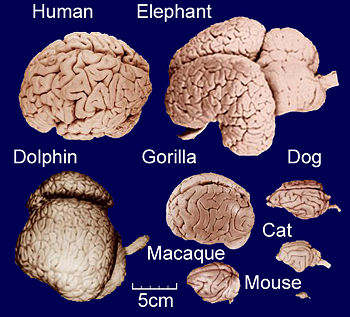Brain size: Difference between revisions
Jump to navigation
Jump to search


imported>Daniel Mietchen (image description) |
imported>Daniel Mietchen (structure) |
||
| Line 1: | Line 1: | ||
{{subpages}} | {{subpages}} | ||
{{DirectRef}} | |||
{{Image|ComparitiveBrainSize.jpg|right|350px|Comparative anatomy of adult brains from various vertebrate species, highlighting the gradual differences in brain size and [[gyrification]].}} | {{Image|ComparitiveBrainSize.jpg|right|350px|Comparative anatomy of adult brains from various vertebrate species, highlighting the gradual differences in brain size and [[gyrification]].}} | ||
Since the size of the [[brain]] has changed considerably during [[hominid evolution]], '''brain size''' is a central term in many discussions related to [[cognitive evolution]], [[intelligence (biology)|intelligence]] and a number of [[brain disorder]]s, especially [[microcephaly]]. To compare different brains, several indicators of brain size have been used. These include ''absolute brain size'', ''relative brain size'' (normalized by body size or weight), and the [[encephalization coefficient]]. | Since the size of the [[brain]] has changed considerably during [[hominid evolution]], '''brain size''' is a central term in many discussions related to [[cognitive evolution]], [[intelligence (biology)|intelligence]] and a number of [[brain disorder]]s, especially [[microcephaly]]. To compare different brains, several indicators of brain size have been used. These include ''absolute brain size'', ''relative brain size'' (normalized by body size or weight), and the [[encephalization coefficient]]. | ||
==Determinants of brain size== | |||
[[microcephalin]] (MCPH1) and [[ASPM]] (MCH 5) (cf. [[CZ:Ref:Stern 2006 Evolutionary Genetics: is brain evolution still continuing in modern humans?|Stern and Woods, 2006]]; [[CZ:Ref:Tang 2006 Molecular genetic determinants of human brain size|Tang 2006]]) | |||
==Correlates of brain size== | |||
*[[Gyrification]] (cf. [[CZ:Ref:Hofman 1989 On the evolution and geometry of the brain in mammals|Hofman 1989]]) | |||
==Effects of brain size== | |||
*[[glia-neuron ratio]] (cf. [[CZ:Ref:Sherwood 2006 Evolution of increased glia-neuron ratios in the human frontal cortex|Sherwood et al., 2006]]) | |||
Revision as of 05:17, 6 January 2009
This article uses direct referencing.

(CC) Photo: University of Wisconsin and Michigan State Comparative Mammalian Brain Collections and National Museum of Health and Medicine (see http://www.brainmuseum.org/)
Comparative anatomy of adult brains from various vertebrate species, highlighting the gradual differences in brain size and gyrification.
Comparative anatomy of adult brains from various vertebrate species, highlighting the gradual differences in brain size and gyrification.
Since the size of the brain has changed considerably during hominid evolution, brain size is a central term in many discussions related to cognitive evolution, intelligence and a number of brain disorders, especially microcephaly. To compare different brains, several indicators of brain size have been used. These include absolute brain size, relative brain size (normalized by body size or weight), and the encephalization coefficient.
Determinants of brain size
microcephalin (MCPH1) and ASPM (MCH 5) (cf. Stern and Woods, 2006; Tang 2006)
Correlates of brain size
- Gyrification (cf. Hofman 1989)